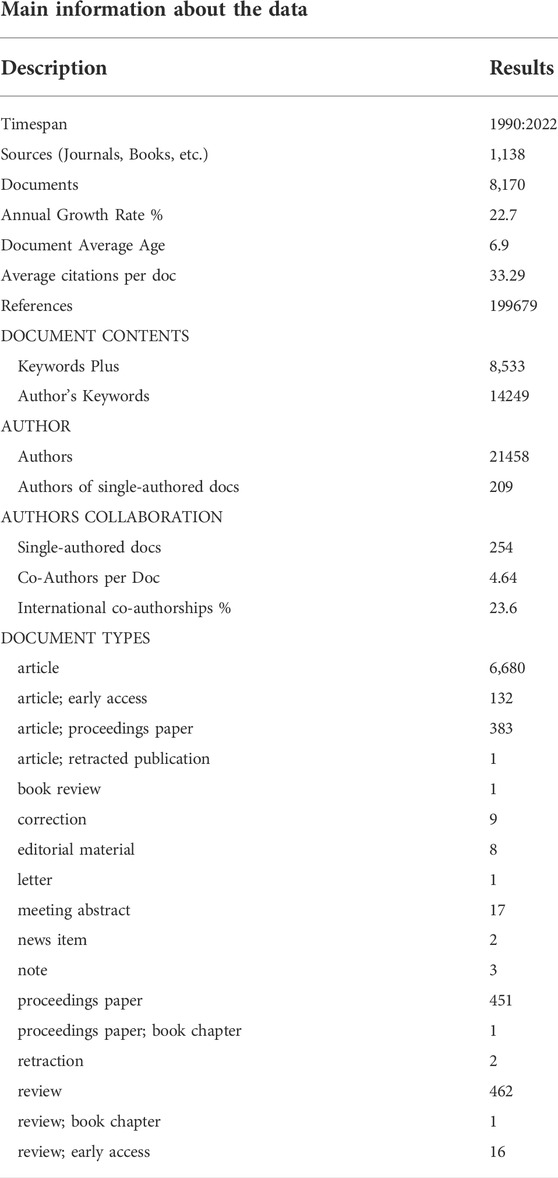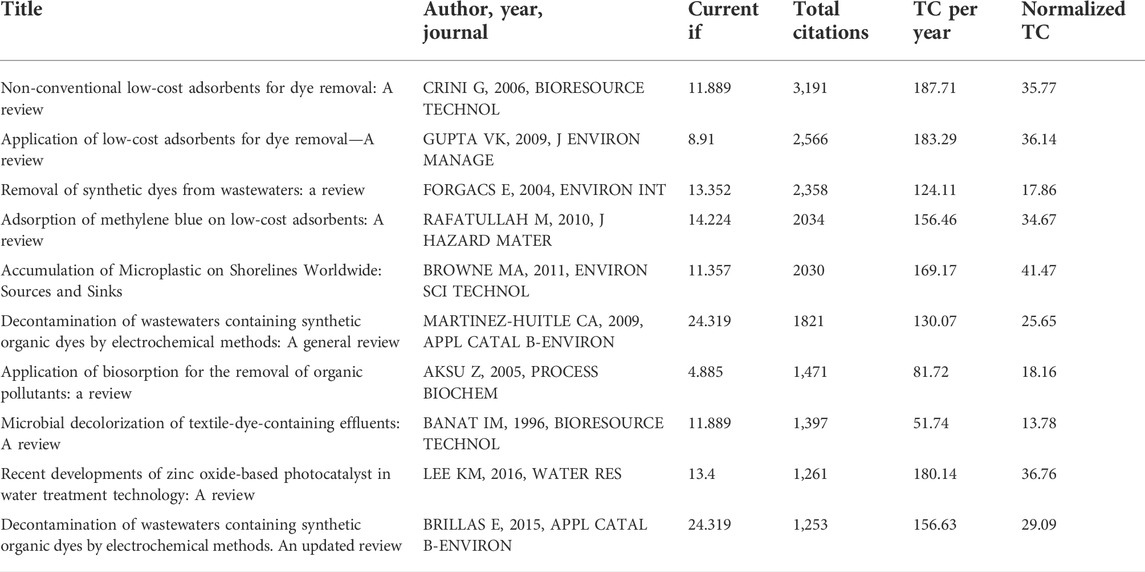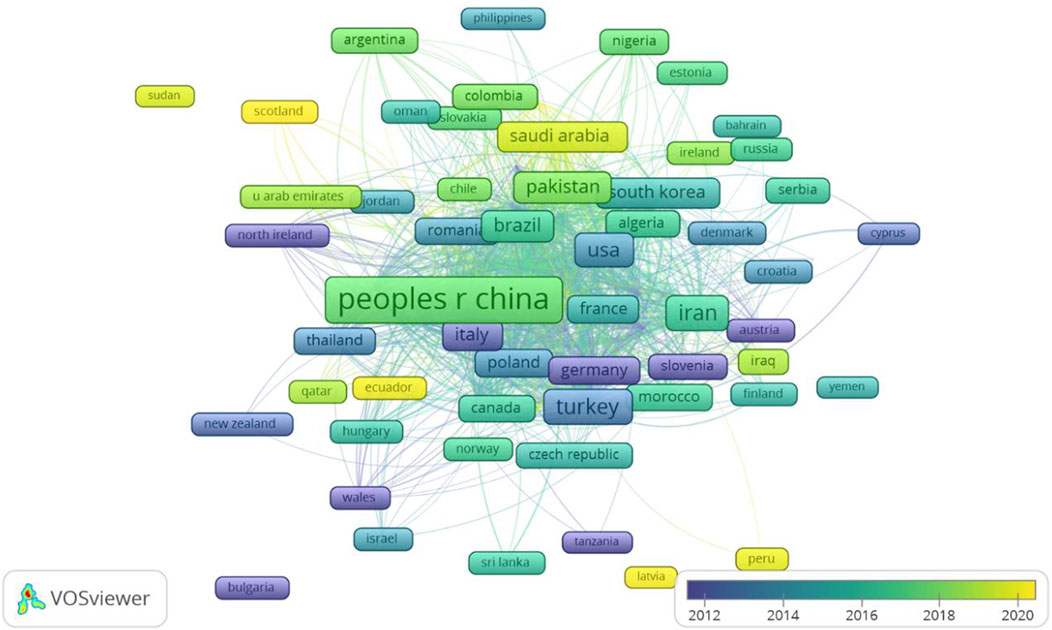Current status and research trends of textile wastewater treatments—A bibliometric-based study
- 1Engineering Research Center of Digitized Textile and Fashion Technology, Ministry of Education, Donghua University, Shanghai, China
- 2College of Information Science and Technology, Donghua University, Shanghai, China
- 3College of Textile Science and Engineering, International Institute of Silk, Zhejiang Sci-Tech University, Hangzhou, China
While introducing new technology has completely transformed the textile production process, the rapid pace of massive industrialization has increased the volume of wastewater, which is highly hazardous. Even though the textile industry is essential to our economy, the textile industry is harmful to the environment because of the production of wastewater, solid wastes, air pollutants, noise, etc. Recycling textile wastewater is crucial, and oxidation, physical, biological, and physicochemical methods can be used to treat textile wastewater. Based on statistics and visualization tools, bibliometric analysis has evolved to demonstrate a given topic’s knowledge structures and developmental tendencies. Here we provide a bibliometric analysis focused on textile wastewater treatment from 1990 to 2022. Raw data was retrieved from the Web of Science (WoS) database and mapped using VOSviewer and biblioshiny. Textile, wastewater, and treatment were keywords. We retrieved 8,170 documents, 1,138 sources published these documents, a 22.7% annual increase, where 21458 authors published these documents with an average citation rate of 33.2%, and there were 6,680 research articles and 462 review articles. DESALINATION AND WATER TREATMENT stayed on top with 422 publications. We discovered that DONGHUA UNIVERSITY ranks first with 330 publications. Though China took first place with a total of 43961 citations, followed by India with a total of 33953 citations, from a total of 120 countries participating in this research, the research work of CRINI G and coworkers was most cited globally. The most common term was wastewater, which occurred 3,144 times, followed by textile, which appeared 2,669 times. We expect this research to be a significant resource for scholars by comprehensively describing the current state and future directions of textile wastewater treatment.
1 Introduction
The term “textile” was first used to describe woven fabrics and the activities that comprised the weaving process. Textile is a flexible woven material made up of a network of natural and synthetic fibers known as threads or yarns (Adane et al., 2021). The term “fabric” refers to any material that is produced by interlacing fibers, whereas “textile” refers to any material that may be utilized in the manufacturing of additional items and may be formed by weaving, knitting, crocheting, etc. (Sghaier et al., 2019). Recently, textile production has been entirely revolutionized by introducing new technologies such as chemical, biological, and physiochemical methods, but with an increase of huge industrialization and human population speed up, the volume of wastewater is perilous for humans and the environment (Yin et al., 2019). However, in the case of common forms of woven textiles, such as plain weave, twill weave, or satin weave, there is not much difference between conventional and modern processes. Besides, the loss of natural water has caused various damages, e.g., droughts, an increase in population, and an increase in the amount of water used by industries, particularly textile manufacturing (Kant, 2012). Because water is essential to life, including human life, the lives of other animals and ecosystems, and the plant, animal, and textile industries, we must conserve it. The recycling and reuse of water via wastewater treatment are several strategies that could be implemented to bring it under control.
Textile industries provide items, goods, and products but also damage the environment via wastewater discharge, solid waste generation, air pollutants, and noise pollution (Tang et al., 2020). Water is used in the textile industry to wash raw materials and many flushing treatments throughout the production process. The chemical and physical processes, including sizing, de-sizing, scouring, bleaching, mercerizing, dying, finishing, and printing, are involved in the production (Shirazinezhad et al., 2021). The wastewater discharged from the textile sector comprises harmful contaminants such as dyes, chromium, NaOH, starch, acid, etc. According to (Kant, 2012) the World Bank, the wastewater created by the dyeing and finishing department accounts for around 17%–20% of total industrial effluent. About 300,000 t of synthetic dyes are reportedly discharged annually into treatment facilities worldwide (Saini, 2017). Besides, the polluted water may include harmful pollutants that impact not only clean water but also the photosynthesis process in aquatic plants (Saravanan et al., 2021). So, it is a significant obstacle to overcome to efficiently allot and manage water, particularly in textile manufacturing activities, i.e., access to electricity, agriculture and which place a premium on environmental responsibility, CO2 emission, carbon information disclosure, renewable energy consumption, energy conservation to obtain sustainable development goals (Ikram et al., 2019; Ikram et al., 2020; Wu et al., 2020; Ikram et al., 2021; Ikram, 2022; Ikram et al., 2022; Wu et al., 2022). By addressing these difficulties with sustainable treatment options, we can stop the flow of water pollution into our local watersheds, safeguarding both the general public’s health and the ecosystems in our surroundings.
Textile wastewater treatment and reuse are viable for saving and augmenting existing water resources and minimizing hazardous pollution discharge into the environment (Al-Qodah, 2000; Al-Qodah and Lafi, 2003; Al-Qodah et al., 2007; Memon et al., 2016). There is growing interest in cleaner technologies (Shaheen et al., 2022); the technologies mentioned earlier, which we have examined in the current research, might be applied in various textile wastewater treatment and reuse processes. Additionally, it has the potential to provide new ideas to researchers, which may lead to the development of new approaches in the future that are more effective. However, these methods and the mentioned treatment may need further research to know each mechanism deeply. In addition, every subsequent tactic has to be explained in considerable detail. This way, the new researcher may understand and further their hypothesis and new approaches in the field of textile water treatments.
Bibliometric analysis is beneficial in understanding research and development in various fields (Zaman et al., 2016; Borregan-Alvarado et al., 2020; Noor et al., 2020; Xizhen and Zhiqin, 2020; Kuilang and Qian, 2021; Mei et al., 2021; Provin et al., 2021; Syed Hamd Hassan et al., 2021; Halepoto et al., 2022a; Awan et al., 2022; Halepoto et al., 2022b; Xiang et al., 2022). The purpose of this study was to provide a summary of the data currently accessible in the published research on textile wastewater treatments and to concentrate on different techniques, particularly highly efficient technology for the treatment of textile wastewater. In brief, this research aimed to answer the following research questions.
1 What are the current mechanisms of wastewater treatment in the textile industry?
2 What is the annual production of documents in the field of wastewater treatment in the textile industry and their yearly citations?
3 What are the most relevant words, sources, and institutions when discussing textile wastewater treatments?
4 What are the most cited authors, document sources, and countries related to textile wastewater treatment?
5 What is the linkage between countries and organizations based on citations in the given field?
This research paper also discusses the relevant processes such as UV/H2O2, Photocatalytic degradation using Nano photocatalysts, TiO2/UV/H2O2, Acoustic cavitation, Ultrafiltration, and Nanofiltration, and mechanisms for treating textile wastewater. For the methods, the relevant literature and data collection were investigated using the Google Scholar database from 2014 to 2022 to search for articles related to textile wastewater and then evaluating the articles found using a more in-depth approach. After that, further information and procedures were obtained using more explicit phrases, such as oxidation techniques and physical and biological methods.
2 Current mechanisms of the textile’s wastewater treatment
Textile wastewater is notorious for posing a substantial difficulty to the normal wastewater treatment procedure due to its comparatively low biodegradability index (Faghihinezhad et al., 2022). Before releasing water containing suspended and dissolved particles into natural water, it must first be purified. In addition, numerous methods have been developed to achieve efficient and cost-effective wastewater treatment. The treatment techniques included oxidation methods, physical methods, biological methods, and physicochemical approaches, which were further categorized into different methods. In the following sections, we will go through various approaches that have recently been reported as being successful in the treatment of textile wastewater.
2.1 Oxidation methods
These are the techniques most often used to decompose dyes and other chemicals found in wastewater. These oxidation processes may be utilized alone or in conjunction with one another, depending on the situation (Kaur et al., 2018). There are several oxidation methods which we discussed one by one in the following section.
2.1.1 UV/H2O2
This method took around 20 min to remove the color entirely and can remove 63% of total organic carbon in 90 min (Bokhari et al., 2020)
2.1.2 Photocatalytic degradation using nano photocatalysts
Its emerging technology is the factor that is responsible for the completion of the mineralization of the dyes. Using nano photocatalysts, the process of photolysis has the potential to partly degrade between 50 and 80% of micro-pollutants like dyes (Jamil et al., 2020).
2.1.3 Combinations of TiO2/UV/H2O2
The decolorization efficiencies in the subsequent UV, UV-H2O2, UV-TiO2, and (UV-TiO2-H2O2) runs were 18%, 27%, 37%, and 64%, respectively. There are 100-min lighting intervals respectively (Dihom et al., 2022).
2.1.4 hydrogen peroxide in subcritical water
The rate of H2O2 conversion to hydroxyl radicals was linked to the experimental temperature. At all dye concentrations and temperatures, 0.5% w/v H2O2 was the best for RR120 degradation. At the most “intense” conditions of 200°C and 1% w/v H2O2 (Raizada et al., 2020).
2.1.5 Acoustic cavitation
Degradation in acoustic and hydrodynamic cavitation ranged from 50 to 60%, depending on the dye and kind of cavitation utilized. Compared to chemical oxidation and acoustic cavitation-based combinations, it is the most efficient decolorization of both dye effluent by combining hydrodynamic cavitation and chemical oxidation (Jadhav et al., 2015)
2.1.6 Hydrodynamic cavitation with H2O2, CCl4, and Fenton’s reagent
Rhodamine is decolored 99.9% using a combination of cavitation and H2O2 and a combination of cavitation and Fenton chemistry. The combination of cavitation and CCl4 results in around 82% deterioration (Mishra and Gogate, 2010).
2.1.7 Hydrodynamic cavitation
For the breakdown of OG into HC, an acidic media (lower pH) is used. For the same amount of energy provided, the slit venturi resulted in a nearly 50% higher deterioration rate and cavitational yield than the other two cavitating devices investigated (Rajoriya et al., 2018).
2.2 Physical methods
Decolorizing wastewater containing dispersion dyes and other compounds may also be accomplished via physical methods. These methods have limited use since they have poor decolorization efficiency and produce a substantial amount of sludge as a consequence (Samuchiwal et al., 2021). Peat, bentonite clay, fly ash, and polymeric resins were some examples of low-cost adsorbent materials that were employed by certain researchers so that the adsorption approach could be economically viable. However, the uses of these adsorbents have been limited by many issues. Therefore, adsorbents should be used for processes with low pollutant concentrations or when the adsorbent is cheap or readily regenerated. The next section describes some of the physical ways that may be used to treat water.
2.2.1 Ultrafiltration is a water purification process in which water is forced through a semipermeable membrane (Alsohaimi et al., 2017).
2.2.2 Nanofiltration is an emerging wastewater treatment technology with advantages such as low energy consumption and simple operation. (Yan et al., 2022).
2.2.3 Loose nanofiltration (LNF) membrane is a new technology where LNF has very positive outcomes, and researchers suggest that the LNF membranes have a huge potential for applying resveratrol-based LNF membranes for the treatment of saline textile wastewater (Ding et al., 2020).
2.2.4 The novel sol-gel assisted interfacial polymerization technique involves an interfacial polymerization reaction and simultaneous generation of titanium dioxide. This approach can tune the performance and morphology of the nanofiltration membranes and endow membranes with self-cleaning properties (Ding et al., 2020).
2.2.5 Reverse osmosis can be described as a diffusion-controlled process in which the mass transfer of ions through RO membranes is controlled by diffusion (Zhao et al., 2021).
2.3 Biological methods
Dissolved materials are the sole component of textile wastewater affected by the biological process. The ratio of organic load to dye load, the load of microorganisms, and the temperature and oxygen content in the system all affect the effectiveness of the removal process (Srivastava et al., 2022). Biological processes are classified into three types based on whether they need oxygen: aerobic, anaerobic, anoxic or facultative, and any combination. The anaerobic process is used to treat high chemical oxygen demand COD textile wastewater, while the aerobic polishing treatment handles low COD textile wastewater generated by the anaerobic process. In real practice, a mix of anaerobic and aerobic approaches is applied (Bhatia et al., 2017). Here are several biological methods that might be utilized in wastewater treatment systems.
2.3.1 Fungal cultures for degradation of dyes
A fungal culture can adjust its metabolic rate in response to changes in the surrounding environment. This talent is very necessary for their continued survival. Both intracellular and external enzymes contribute to the metabolic activity here. These enzymes can break down a variety of colors that are found in effluent from the textile industry (Abd El-Rahim et al., 2017).
2.3.2 Algae for degradation dyes
The enzymes break the bonds that make up the chemical structure of the dye, allowing it to be changed into other chemical compounds. On the other hand, biosorption refers to transferring color from the liquid to the solid phase. According to a recent article, green macroalgae species of the genus Cladophora can break down azo dyes, in particular due to the presence of the enzyme azoreductase (Pavithra et al., 2020).
2.3.3 Microbial fuel cell
In a microbial fuel cell system, electrochemically active microorganisms in the anode chamber oxidize various organic compounds found in textile wastewater. This process generates protons and electrons, which are then transported to the cathode chamber, where oxygen is reduced to water (Holkar et al., 2018).
2.4 Physiochemical methods
Nowadays, the primary goal of water pollution is developing economic and effective methods for treating wastewater discharges from the textile industry to protect aquatic life in water bodies. The most common physiochemical methods used to treat textile wastewater are ion exchange, adsorption, irradiation, and oxidation, yielding valuable results (Jain et al., 2020). Coagulation and flocculation methods are effective for the color removal of disperse and sulfur dyes, and they show limited capacity for chemical and vat dyes. In addition, low treatment performance and significant sludge production limit the use of the above methods. Adsorption methods have gained considerable interest due to their improved removal performance based on high affinity, target compound capability, and adsorbent regeneration preference. The following are some of the methods which have been reported recently and could be used for the treatment of wastewater.
2.4.1 Oxidation
Complete decolorization of dyes is obtained by removing the chromophores group. This procedure is extremely straightforward and effective. However, this results in the production of sludge, more significant material costs, and increased energy usage (Duan et al., 2020).
2.4.2 Ozonation
Complete elimination of COD when applied when in the gaseous form. Ozone has a limited half-life and is very costly to provide continuously (Rekhate and Srivastava, 2020).
2.4.3 Adsorption
It is efficient, has a large capacity, and is an excellent choice for acid dyes, reactive dyes, dispersion dyes, and vat dyes. The production of by-products, the high cost of synthesis and regeneration, and the inefficiency of the process in dealing with certain dyes (Danaci et al., 2021).
2.4.4 Membrane Separation
This method may be accomplished by removing COD, salinity, and dyes. High cost of operation, the tendency for the membrane to get blocked, and perform well in conditions of both high volume and pressure (Argenta and Scheer, 2020).
2.4.5 Ion exchange
It works well for soluble dyes, and the solvent may be recovered easily. The running costs are higher, and it is not appropriate to use the dyes in concentrations, but it is effective for dispersion dyes (Hassan and Carr, 2018).
2.4.6 Coagulation
It is simple and consistent with economic viability. The creation of sludge, an increase in the expense of the coagulant, and a challenge in terms of disposal (Singh and Ransingh, 2020).
2.4.7 Electrocoagulation
It uses fewer chemicals and is straightforward to run. Costs are associated with high energy usage, electrode replacement, and the creation of sludge (Zazou et al., 2019).
3 Bibliometric analysis
Based on statistics and visualization tools, bibliometric analysis has evolved as the method to show the knowledge structures and developmental tendencies of a certain topic (Devos and Menard, 2019; Ma et al., 2021). It would be able to use publishing data to identify research trends objectively and hot themes, evaluate author and institution productivity and map out networks of international collaboration and geographical dispersion (Lu et al., 2021; Ou et al., 2022). There are several bibliometric analysis tools available. Each tool has its pros and cons; therefore, it is advised to use multiple tools (Choudhri et al., 2015; Karanatsiou et al., 2017; Chen, 2020; Markscheffel and Schröter, 2021). CiteSpace, VOSviewer, and R-bibliometrix are the software packages utilized most extensively for bibliometric and visualized analysis. These tools can be utilized to extract the essential information contained within the included publications. This information includes countries/regions, institutions, authors, journals, keywords, and co-cited references. These programs can identify the most contributed authors, institutions, and countries/regions from cooperative networks and select interested publications. There are several databases available to obtain raw data. PubMed, one of the most popular and frequently used search engines for medical literature, was developed by the National Library of Medicine and released in 1997 as an accessible interface to the MEDLINE database. PubMed’s primary drawbacks are 1) its focus on the biomedical and life sciences journal literature and 2) its lack of robust citation analysis (Choudhri et al., 2015).
Scopus, released in 2004, is Elsevier’s largest online bibliometric database, containing journal articles from all major disciplines published from 1966 onward, including those from the social and physical sciences that are not included in PubMed. Scopus’s citation analysis features are more robust than PubMed’s, and it now covers publications produced after 1996; however, there are plans to expand archiving to cover articles published as far back as 1970 (https://www.scopus.com/home.uri). Thomson Reuters Web of Science (WoS) has fewer articles than Scopus. However, it does include articles published after 1900. WoS, like Scopus, indexes journal articles from all relevant fields of study; however, the breadth of its coverage is slightly narrower. The citation analysis in WoS is quite strong. WoS contains Science Citation Index Expanded, which is used for scientific disciplines; Social Sciences Citation Index, which is used for a social science discipline; Arts & Humanities Citation Index, which is used for arts and humanities disciplines; Emerging Sources Citation Index, which covers up to 254 disciplines; Book Citation Index (BKCI) which covers over 104,500 editorially selected books and Conference Proceedings Citation Index (CPCI). This multidisciplinary index is the fastest access to cutting-edge, impactful research from conference proceedings.
In this paper, we provide the results of a bibliometric study covering the period from 1990 to 2022. This study focuses on the treatment of textile wastewater. We anticipate that this research will shed light on the current state and future directions of textile wastewater treatment and will serve as a useful resource for researchers.
4 Materials and methods
Data gathering is the first phase of a bibliometric study, followed by bibliometric and statistical representations (Ahmad and Slots, 2000; Wilson et al., 2021). WoS database, one of the most significant databases of scientific publications, is often regarded in bibliometric analysis for its comprehensive information (Archambault et al., 2009). This database may be found at http://apps.webofknowledge.com. The raw data can be extracted in different formats. We have extracted the raw data in plain text format and used VOSviewer and R tool, biblioshiny, to map the data.
4.1 Search strategy and collection of the data
The WoS database was used for raw data collection. We have selected the Web of Science in general rather than the “Core Collection” option only. The key terms used were ‘Textile,” “wastewater,” and “treatment.” A total of 8,170 documents were retrieved in plain text file format. These plain text files were combined using a Python application. For downstream analysis, a single plain text file was created that contained all the 8,170 documents.
4.2 Bibliometric and visualized analysis
After combining all the files into a single file, we used the R tool, biblioshiny, and the VOSviewer (1.6.18) tool to analyze the data and extract the information. VOSviewer is a software application for building and displaying bibliometric networks. These networks can be formed based on citation, bibliographic coupling, co-citation, or co-authorship relationships, and they may include journals, researchers, or individual articles. VOSviewer also has text mining capabilities that can be utilized to generate and visualize co-occurrence networks of key terms retrieved from a body of scientific literature. R-bibliometrix (R 4.1.2) can be used to conduct quantitative analysis.
5 Results
5.1 Main information
A total of 8,170 documents were found using the critical strings shown in the above lines. The time duration was from1990 from 2022. A total of 1,138 sources were involved in publishing these documents, with an annual growth of 22.7%. 21458 authors have published these documents with an average citation per document of 33.29%. There were 209 single-author documents. There were 6,680 research articles and 462 review articles, including others. Two articles were being retracted. A detailed description is provided in Table 1.
5.2 Annual production of the documents
Our data can be traced back to 1990. The first article was published in 1990, entitled “Nonpriority Analysis of the Wastewater Streams of Four Dye Manufacturing Facilities.” The publication source was Wiley; the journal was “Research Journal of the Water Pollution Control Federation.” This was the only one article published during the whole year. A total of 8 documents were published the following year. A smooth growth can be seen in the publication of the documents from 1994 to 2008, as shown in Figure 1. Triple figures digit in a calendar year was reached in 2003 when a total of 109 documents were published. Five hundred digits were reached in 2017 when a total of 512 documents were published. In 2021, a four-digit figure was reached, and a total of 1,046 documents were published.
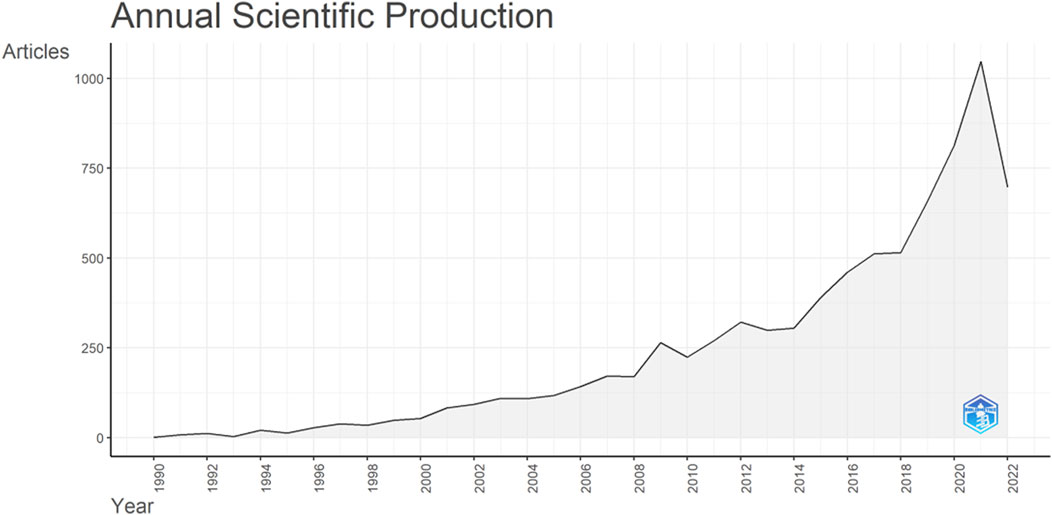
FIGURE 1. Annual scientific production over time. The x-axis indicates years, while the y-axis indicates several articles published.
5.3 Article citations per year
We have analyzed the data to extract the annual citations. The average citations of the documents were not smooth, and a zigzag graph was mapped based on the data, although continuous growth was seen. In 2004, a peak was formed when the average citations reached 7.3 per year. There was a decline, and in 2013, only 3.6 average citations were observed. Since then, there has been a rise in the document’s average citations. In 2020, the maximum number of citations observed was 8.6, whereas a decline in the following years, as shown in Figure 2.

FIGURE 2. Average article citation per year. The x-axis indicates the years, while the y-axis indicates the average number of citations.
5.4 Most relevant sources
We have found that a total of 1,138 sources engaged in the publication of the entire literature. We analyzed the data to find the top ten most relevant sources based on the number of publications, as shown in Figure 3. DESALINATION AND WATER TREATMENT, Print ISSN: 1944–3,994 Online ISSN: 1944–3,986, remained on the top with 422 publications. This journal publishes 60 issues per annum. It states, “Due to the galloping growth of the desalination field to help supply water to an exploding active thirsty population, there has been a surge in the number of scientists and engineers involved in water desalting and wastewater reclamation. The coverage needs to be extended to accommodate additional selected papers promptly. We are ready to meet this challenge with this new publication. Desalination and Water Treatment is dedicated to researching and applying desalination technology, environment and energy considerations, integrated water management, water reuse, wastewater, and related topics. We are turning to main players in the field to support the venture by participating in the publication and subscribing to the new journal in electronic and print form.” This journal was launched in 2009 and is indexed in the world’s leading databases like the web of science, Scopus, etc. WATER SCIENCE AND TECHNOLOGY, ISSN 0273–1223 EISSN 1996–9,732, comes in the second position with a total of 254 publications. Initially launched by ScienceDirect, the Water science and technology journal was transferred to “The International Water Association” in 2000.
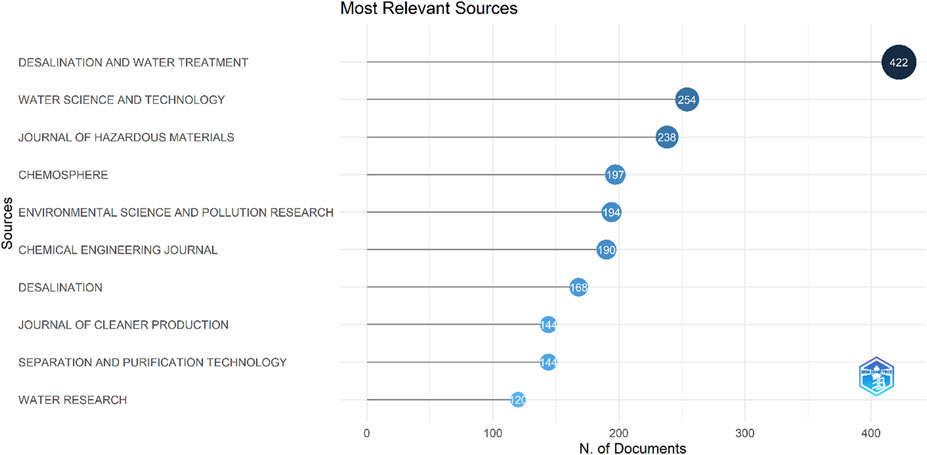
FIGURE 3. Most relevant sources. The x-axis indicates the number of documents; the y-axis shows the sources. The top 10 most relevant sources have been identified based on the number of publications.
5.5 Most local cited sources
Citing an article by other scientists increases the value of the documents. Usually, it is believed that more citations of a particular document mean that more people have benefited from this document. Similarly, if a source (Journal, book, magazine, etc.) has received a certain number of citations, it is considered more relevant. We have analyzed the data and extracted the top 10 mostly cited sources, as shown in Figure 4. JOURNAL OF HAZARDOUS MATERIALS stands on the top, having 19582 articles citations. The Impact Factor of this journal is 14.224, indexed in 17 international databases, ranking it 9 out of 279 in Environmental Sciences, according to JCR reports. WATER RESEARCH which is a journal of the International Water Association (IWA), scored the second position having 13011 articles citations. The Impact Factor of this journal is 13.400, indexed in 17 international databases, ranking it 1 out of 100 in Water Resources.
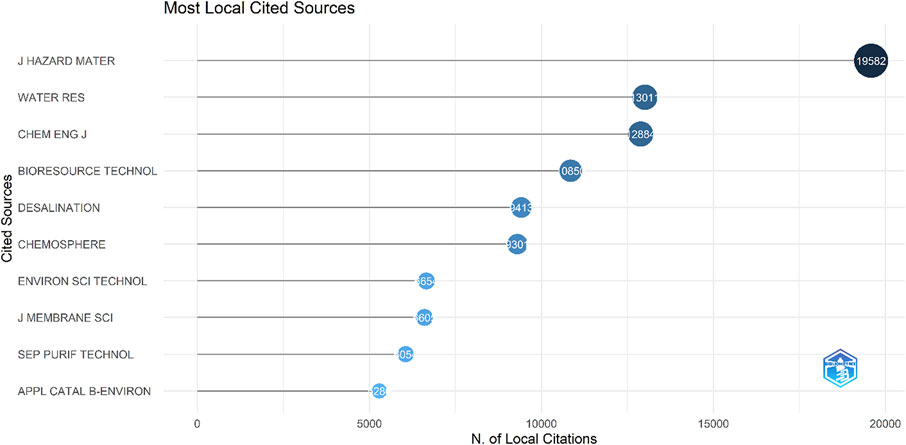
FIGURE 4. Most local cited Sources (from reference list). The x-axis indicates the number of citations; the y-axis shows the source name.
5.6 Most relevant institutions
Several institutions were involved in the research, as shown in Figure 5. We found that DONGHUA UNIV (Donghua University English Website (dhu.edu.cn)) stands at the top with a total of 330 articles. This is one of the best Chinese universities, founded in 1951. This university has a separate college of textiles [Textiles (dhu.edu.cn)]. WUHAN TEXT UNIV (WUHAN TEXTILE UNIVERSITY (wtu.edu.cn) comes in a position second with a total of 281 articles.
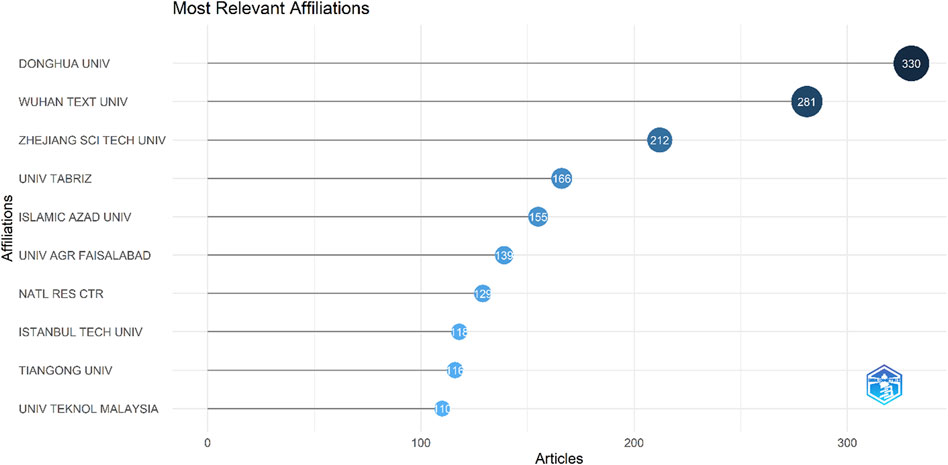
FIGURE 5. Most relevant affiliations. The x-axis indicates the number of articles, while the y-axis indicates the name of the institutions.
56 Corresponding author’s country The Corresponding Author is the point of contact for the manuscript and related communications at all stages of publication, including final proofreading. Different publishers have different rules for assigning corresponding author(s). For example, some publishers allow a few corresponding authors in a single document, while others are strict with a single person as the corresponding author. We have analyzed the data to find the most relevant corresponding authors based on their affiliation country. We have found that China remained on the top with a total of 360 MCP (Multiple Country Publications) and 1636 SCP (Single Country Publications). India scored the second position having a total of 165MCP and 756 SCP, as shown in Figure 6.
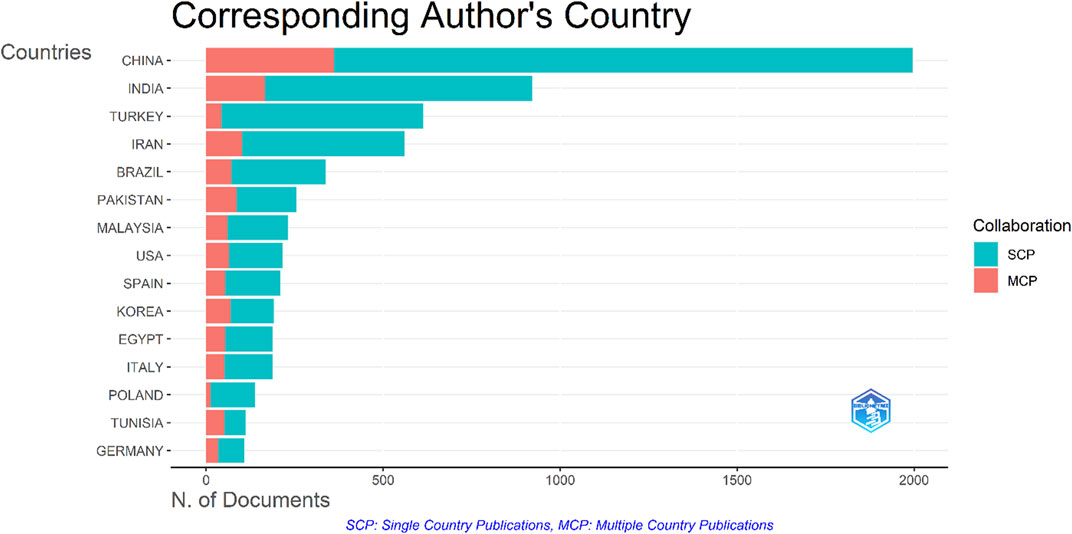
FIGURE 6. Corresponding author’s country. The x-axis indicates the number of documents published, while the y-axis indicates the country name. The top 10 countries are shown here based on the number of publications.
5.7 Most cited countries
Documents citations indicate it is usefulness to the public and scientists. We have analyzed the data to extract the most cited countries, as shown in Figure 7. China, with a total of 43961 citations, scored the first position, followed by India, with a total of 33953 citations. The United States stands in position 6, having a total of 10821 citations.
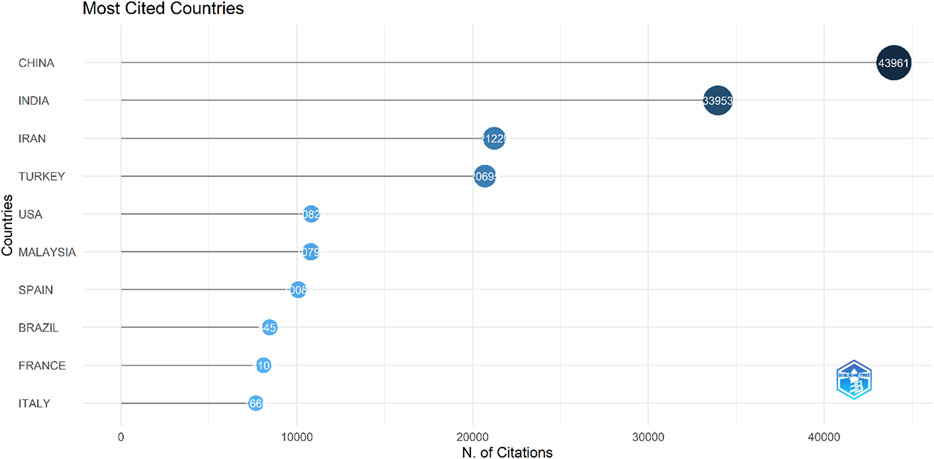
FIGURE 7. Most cited countries. The top 10 most cited countries are shown. The X-axis indicates the number of citations, while the y-axis indicates the country’s name.
5.8 The most global cited document
Citing a document by researchers is usually based on its usefulness to the scientific community and the public. A mostly cited document means it has more impact. We have analyzed the data to extract the most global documents. The top 10 most cited documents are shown in Table 2. The most cited article was a review paper with total citations of 3,191, published by Gregorio Crini (Crini, 2006), entitled “Non-conventional low-cost adsorbents for dye removal: A review.” In this article, the author has discussed the adsorption techniques that are widely used to remove certain classes of pollutants from water, especially those that are not easily biodegradable. This article was published by “Bioresource Technology” journal, one of the top leading journals in the field, in 2006.
5.9 Most relevant words
It is important to dig out the most relevant words from the data. We have extracted the most relevant words from four different categories, as shown in Figure 8. From the titles, wastewater was the most relevant term appearing 3,144 times, followed by textile, which appeared 2,669 times, Figure 8A. From the author’s keywords, textile wastewater was the most relevant term appearing 965 times, followed by adsorption, which appeared 799 times, and the third most common term was wastewater, with a frequency of 606, Figure 8B. From the keywords plus, removal was the leading term that appeared in 2003 times followed by degradation with 1,583 times of frequencies, Figure 8C. From abstracts, wastewater was the most common term with a frequency of 13724, followed by a dye, which appeared 10220 times. The third most common term was textile, with a frequency of 9,220 occurrences, Figure 8D.
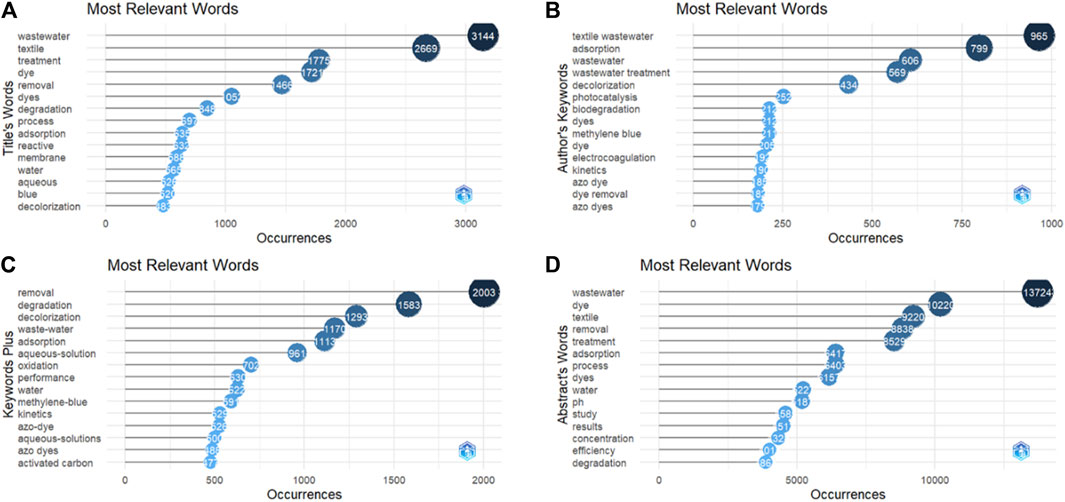
FIGURE 8. Most relevant terms. (A). Most relevant terms extracted from the titles, (B). Author’s keywords, (C). Keywords plus, and (D). Abstracts.
5.10 Word cloud
We have analyzed the data to extract the WordCloud. We have used keywords plus and titles to extract the words for WordCloud. We found that the “Wastewater,” and “Adsorption,” etc. Were the leading words from the keywords plus, refer to Figure 9A, while the “textile,” “treatment,” and removal, etc., were the leading words extracted from the titles Figure 9B. Similar results for the words extracted from the abstracts, refer to Figure 9C.
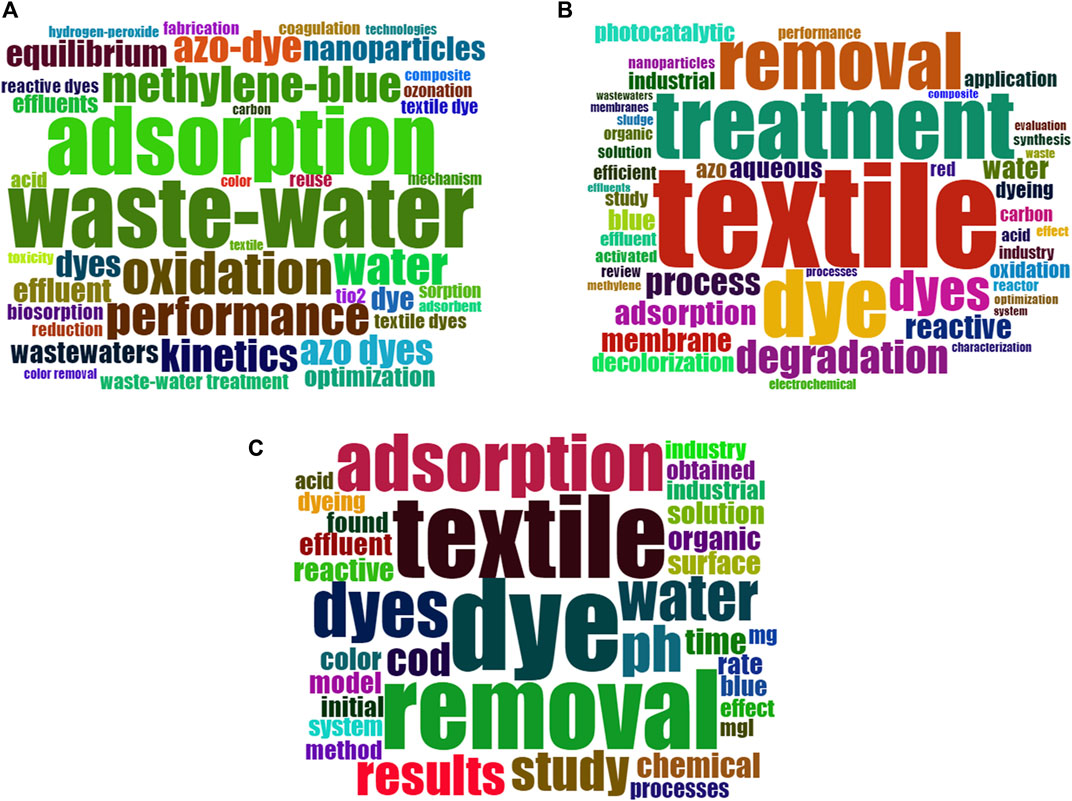
FIGURE 9. (A) WordCloud, words extracted from the keywords plus. The word “wastewater” was the leading word (B). Wordcloud, extracted from titles. The word “textile” was the leading term (C). Wordcloud from abstracts. The “removal” was the leading word.
5.11 Co-occurrence map, the linkage
Term co-occurrence map, terms were extracted from “titles,” and the counting method was chosen as “Binary.” The minimum occurrences of the term were chosen as 10 out of 16743 terms; a total of 456 terms met this threshold. “Wastewater” appeared 1,008 times, “Removal” was the second most used term, which appeared 973 times, “treatment” was the third most used term, appearing 836 times, followed by “textile wastewater,” which appeared 697 times, as shown in Figure 10.
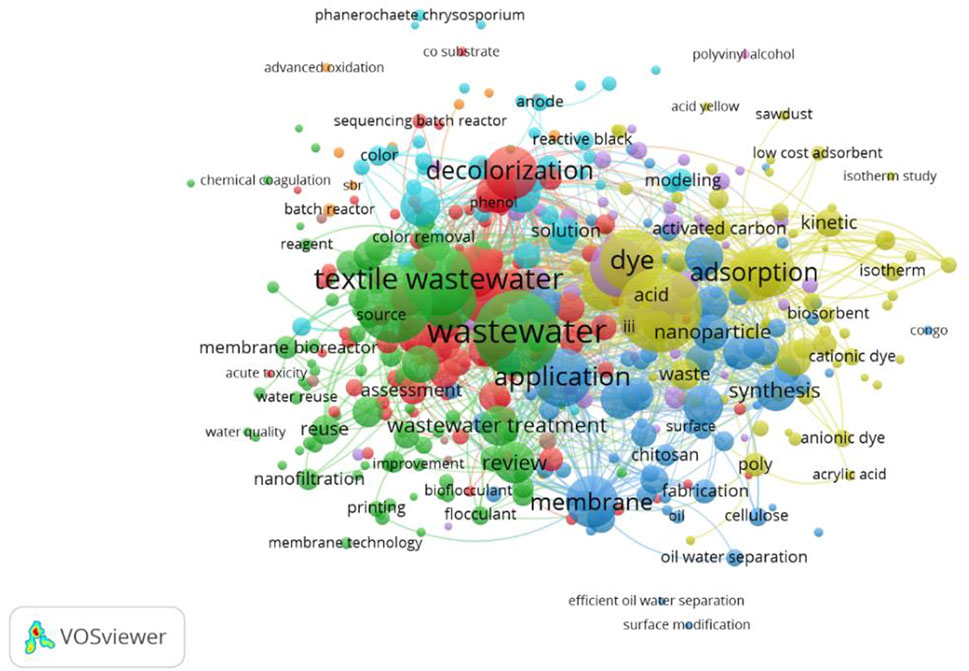
FIGURE 10. Terms co-occurrence map. Wastewater and textile wastewater were linked to most of the terms.
5.12 Countries linkage based on citations
A total of 120 countries participated, with a minimum of five documents; 79 countries met this threshold; the People's Republic of China stood on the top, with a total of 2003 documents, followed by India with a total of 1,037 documents, Figure 11.
5.13 Organizations linkage based on citations
The organization linkage based on citations was analyzed using VOS Viewer, and a total of 5,227 organizations participated; we have chosen a minimum number of documents of an organization as 5,731 organizations met this threshold, and Donghua University stood on the top with a total of 222 documents that earned 6,011 citations. Wuhan Textile University remained the second, with 200 documents that have earned 3,416 citations. Zhejiang Sci-Tech University scored third with 148 documents that have earned 2,811 citations, Figure 12.
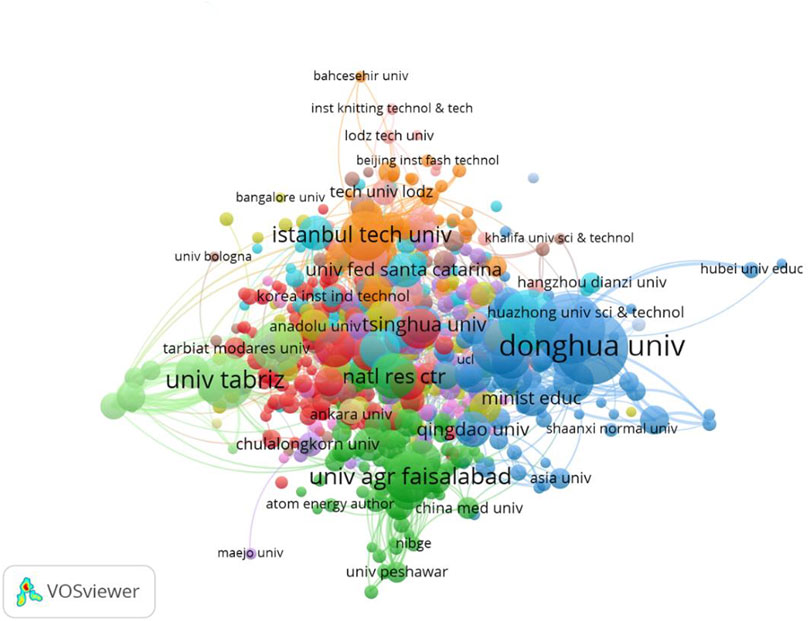
FIGURE 12. Organizational linkage is based on citations. Donghua university was linked to the maximum number of institutions.
6 Discussion
The term “textile” was first used to describe woven fabrics and the activities that comprised the weaving process. Textile is a flexible woven material made up of a network of natural and synthetic fibers known as threads or yarns (Adane et al., 2021). The term “fabric” refers to any material that is produced by interlacing fibers, whereas “textile” refers to any material that may be utilized in the manufacturing of additional items and may be formed by weaving, knitting, crocheting, etc. (Sghaier et al., 2019). Recently, textile production was entirely revolutionized by introducing new technologies, but an increase in massive industrialization sped up the volume of wastewater which is very dangerous for humans and the environment (Yin et al., 2019). However, in the case of common forms of woven textiles, such as plain weave, twill weave, or satin weave, there is not much difference between conventional and modern processes. Besides, the loss of natural water resources has been caused by various factors, e.g., droughts, population increase, and the amount of water used by industries, particularly textile manufacturing (Kant, 2012). Textile industries provide items but also damage the environment via wastewater discharge, solid waste generation, air pollutants, and noise pollution (Tang et al., 2020). The wastewater discharged from the textile sector comprises harmful contaminants such as dyes, chromium, NaOH, starch, acid, etc. According to (Kant, 2012) the World Bank, the wastewater created by the dyeing and finishing department accounts for around 17–20% of total industrial effluent. About 300,000 t of synthetic dyes are reportedly discharged into treatment facilities worldwide (Saini, 2017). Besides, the polluted water may include harmful pollutants that impact not only clean water but also the photosynthesis process in aquatic plants (Saravanan et al., 2021). Therefore, recycling the wastewater created by the textile sector is of the utmost significance. Textile wastewater is notorious for posing a substantial difficulty to the normal wastewater treatment procedure due to its comparatively low biodegradability index (BI) (Faghihinezhad et al., 2022). Before releasing water containing suspended and dissolved particles into natural water, it must first be purified. In addition, numerous methods have been developed to achieve efficient and cost-effective wastewater treatment. The treatment techniques included oxidation methods, physical methods, biological methods, physicochemical approaches, etc. Based on statistics and visualization tools, bibliometric analysis has evolved as the method to show the knowledge structures and developmental tendencies of a certain topic (Devos and Menard, 2019; Ma et al., 2021). It could use publishing data to identify research trends objectively and hot themes, evaluate author and institution productivity and map out networks of international collaboration and geographical dispersion (Lu et al., 2021; Ou et al., 2022). There are several bibliometric analysis tools available. Each tool has its pros and cons; therefore, it is advised to use multiple tools (Choudhri et al., 2015; Karanatsiou et al., 2017; Chen, 2020; Markscheffel and Schröter, 2021). Here we provide the results of a bibliometric study covering the period from 1990 to 2022. This study focuses on the treatment of textile wastewater. WoS database, one of the most significant databases of scientific publications, was used to extract the raw data from other researchers (Archambault et al., 2009). We have extracted the raw data in plain text format and used VOSviewer and R tool, biblioshiny, to map the data (Choudhri et al., 2015). The key terms used were “Textile,” “wastewater,” and “treatment.” A total of 8,170 documents were retrieved. The time duration was from1990 from 2022. A total of 1,138 sources were involved in publishing these documents, with an annual growth of 22.7%. 21458 authors have published these documents with an average citation per document of 33.29%. There were 209 single-author documents. There were 6,680 research articles and 462 review articles including others. Our data can be traced back to 1990. Our findings are in line with the previously published research (Anuar et al., 2022; Wang et al., 2022; Yang et al., 2022). The first article had been published in 1990. This was the only one article been published during the whole year. A total of eight documents have been published the following year. Triple figures digit in a calendar year was reached in 2003, when a total of 109 documents been published. Five hundred digit was reached in 2017, when a total of 512 documents been published. In 2021, a four-digit figure was reached and a total of 1,046 documents been published. We have analyzed the data to extract the annual citations. In 2020, the maximum number of the citation been observed which was 8.6. DESALINATION AND WATER TREATMENT, Print ISSN: 1944–3,994 Online ISSN: 1944–3,986, remained on the top with 422 publications. On the other hand, JOURNAL OF HAZARDOUS MATERIALS stands on the top, having 19582 articles citations. The Impact Factor of this journal is 14.224, indexed in 17 international databases. We found that DONGHUA UNIVERSITY stands at the top with 330 articles. We have found that China remained on the top with a total of 360 MCP (Multiple Country Publications) and 1636 SCP (Single Country Publications). India scored the second position having a total of 165 MCP and 756 SCP. Similarly, China, with a total of 43961 citations, scored first, followed by India, with a total of 33953 citations. The United States stands in position 6, having a total of 10821 citations. The most cited article was a review paper with a total citation of 3,191, published by Gregorio Crini (Crini, 2006), entitled “Non-conventional low-cost adsorbents for dye removal: A review.” In this article, the author has discussed the adsorption techniques that are widely used to remove certain classes of pollutants from water, especially those that are not easily biodegradable. From the titles, wastewater was the most relevant term, appearing 3,144 times, followed by textile, which appeared 2,669 times; from the author’s keywords, textile wastewater was the most relevant term appearing 965 times, followed by adsorption, which has been appeared 799 times, and the third most common term was wastewater, with a frequency of 606. From the keywords plus, removal was the leading term that appeared in 2003, followed by degradation with 1,583 times frequencies. From abstracts, wastewater was the most common term with a frequency of 13724, followed by a dye that appeared 10220 times. The third most common term was textile, with 9,220 occurrences. Our findings follow other researchers (Chen et al., 2022). A total of countries 120 countries have participated. We anticipate that this research will shed light on the current state and future directions of textile wastewater treatment and will serve as a useful resource for researchers.
7 Conclusion
7.1 Summary
This research presents an overview of textile wastewater and its treatment and then conducts a bibliometric analysis of papers obtained from 1990 to 2022 of 8,170 documents retrieved from the WoS and mapped using VOSviewer and biblioshiny. A detailed review shows that oxidation, physical, biological, and physiochemical methods are the current wastewater treatment mechanisms in the textile industry. This research examines some essential characteristics of retrieved documents in terms of annual publications, publishing categories, and publication sources using the bibliometrix software. This field has gained particular importance over the past years; for instance, in 2021, 1,046 documents were published. We may conclude that the problem of textile wastewater treatment has gotten much attention over the years, and international collaboration is reasonably close. In 2004, the average number of citations reached its maximum, increasing and decreasing over the years. The country/region distribution map of publications and cooperation networks is then built, and the highly cited papers are examined. Though the most cited institution was Donghua University, and the most cited country was fund China, neither the most cited author nor the most cited article was from China, CRINI G’s work was found to be the most cited article globally. This is due to more researchers from Chinese institutions than from other regions. Interestingly, the most relevant sources were DESALINATION AND WATER TREATMENT, a well-known research journal; however, the JOURNAL OF HAZARDOUS MATERIALS could get more attention from authors, and most of the authors in this field of textile wastewater treatment have preferred citing from it.
7.2 Research implications, limitations and future suggestions
This work would be beneficial for not only academia abut also for textile industry to know the current status of the given field in very precise way. Moreover, it would be useful for policy makers to encourage emphasis on the utilization of textile wastewater management. Because the bibliometric analysis is carried out using only the documents acquired from WoS, it is possible that the documents that have been collected do not provide a complete picture of the topic. As a result, the comments in this paper are subject to several restrictions. It is suggested that in the future, other bibliometric methodologies should be utilized, and additional datasets besides WoS should be included. In addition, there can be future research work in detail, for example, whether the citations mentioned were self-cited, citations added by reviewers or editorial suggestions, irrelevant citations, and so on, to address the clear importance of the work.
Data availability statement
The raw data supporting the conclusion of this article will be made available by the authors, without undue reservation.
Author contributions
Conceptualization, HH and HM; methodology, HH; software, HH; validation, HH; formal analysis, HH; investigation, HH; resources, HH; data curation, HH; writing—original draft preparation, HH; writing—review and editing, HM and TG; visualization, HH and TG; supervision, TG; project administration, TG and HM; funding acquisition, HM. All authors have read and agreed to the published version of the manuscript.
Funding
This work was supported by the Research Fund for International Scientists (RFIS-52150410416) National Natural Science Foundation of China and National Natural Science Foundation of China 61673007.
Conflict of interest
The authors declare that the research was conducted in the absence of any commercial or financial relationships that could be construed as a potential conflict of interest.
Publisher’s note
All claims expressed in this article are solely those of the authors and do not necessarily represent those of their affiliated organizations, or those of the publisher, the editors and the reviewers. Any product that may be evaluated in this article, or claim that may be made by its manufacturer, is not guaranteed or endorsed by the publisher.
Supplementary Material
The Supplementary Material for this article can be found online at: https://www.frontiersin.org/articles/10.3389/fenvs.2022.1042256/full#supplementary-material.
References
Abd El-Rahim, W. M., Moawad, H., Azeiz, A. Z. A., and Sadowsky, M. J. (2017). Optimization of conditions for decolorization of azo-based textile dyes by multiple fungal species. J. Biotechnol. 260, 11–17. doi:10.1016/j.jbiotec.2017.08.022
Adane, T., Adugna, A. T., and Alemayehu, E. (2021). Textile industry effluent treatment techniques. J. Chem. 2021, 2021. doi:10.1155/2021/5314404
Ahmad, P., and Slots, J. (2000). A bibliometric analysis of periodontology. Periodontol. 85, 237–240. doi:10.1111/prd.12376
Al-Qodah, Z. (2000). Adsorption of dyes using shale oil ash. Water Res. 34, 4295–4303. doi:10.1016/s0043-1354(00)00196-2
Al-Qodah, Z., and Lafi, W. (2003). Adsorption of reactive dyes using shale oil ash in fixed beds. J. Water Supply Res. Technology-Aqua 52, 189–198. doi:10.2166/aqua.2003.0019
Al-Qodah, Z., Lafi, W., Al-Anber, Z., Al-Shannag, M., and Harahsheh, A. (2007). Adsorption of methylene blue by acid and heat treated diatomaceous silica. Desalination 217, 212–224. doi:10.1016/j.desal.2007.03.003
Alsohaimi, I. H., Kumar, M., Algamdi, M. S., Khan, M. A., Nolan, K., and Lawler, J. (2017). Antifouling hybrid ultrafiltration membranes with high selectivity fabricated from polysulfone and sulfonic acid functionalized TiO2 nanotubes. Chem. Eng. J. 316, 573–583. doi:10.1016/j.cej.2017.02.001
Anuar, A., Marwan, N. F., Smith, J., Siriyanun, S., and Sharif, A. (2022). Bibliometric analysis of immigration and environmental degradation: Evidence from past decades. Environ. Sci. Pollut. Res. 29, 13729–13741. doi:10.1007/s11356-021-16470-1
Archambault, É., Campbell, D., Gingras, Y., and Larivière, V. (2009). Comparing bibliometric statistics obtained from the web of science and Scopus. J. Am. Soc. Inf. Sci. Technol. 60, 1320–1326. doi:10.1002/asi.21062
Argenta, A. B., and Scheer, A. D. P. (2020). Membrane separation processes applied to whey: A review. Food Rev. Int. 36, 499–528. doi:10.1080/87559129.2019.1649694
Awan, U., Sroufe, R., and Bozan, K. (2022). Designing value chains for industry 4.0 and a circular economy: A review of the literature. Sustainability 14, 7084. doi:10.3390/su14127084
Bhatia, D., Sharma, N. R., Singh, J., and Kanwar, R. S. (2017). Biological methods for textile dye removal from wastewater: A review. Crit. Rev. Environ. Sci. Technol. 47, 1836–1876. doi:10.1080/10643389.2017.1393263
Bokhari, T. H., Ahmad, N., Jilani, M. I., Saeed, M., Usman, M., Haq, A. U., et al. (2020). UV/H2O2, UV/H2O2/SnO2 and Fe/H2O2 based advanced oxidation processes for the degradation of disperse violet 63 in aqueous medium. Mat. Res. Express 7, 015531. doi:10.1088/2053-1591/ab6c15
Borregan-Alvarado, J., Alvarez-Meaza, I., Cilleruelo-Carrasco, E., and Garechana-Anacabe, G. (2020). A bibliometric analysis in industry 4.0 and advanced manufacturing: What about the sustainable supply chain? Sustainability 12, 7840. doi:10.3390/su12197840
Chen, C. A. (2020). A glimpse of the first eight months of the COVID-19 literature on microsoft academic graph: Themes, citation contexts, and uncertainties. Front. Res. Metr. Anal. 5, 607286. doi:10.3389/frma.2020.607286
Chen, Y., Lin, M., and Zhuang, D. (2022). Wastewater treatment and emerging contaminants: Bibliometric analysis. Chemosphere 297, 133932. doi:10.1016/j.chemosphere.2022.133932
Choudhri, A. F., Siddiqui, A., Khan, N. R., and Cohen, H. L. (2015). Understanding bibliometric parameters and analysis. Radiographics 35, 736–746. doi:10.1148/rg.2015140036
Crini, G. (2006). Non-conventional low-cost adsorbents for dye removal: A review. Bioresour. Technol. 97, 1061–1085. doi:10.1016/j.biortech.2005.05.001
Danaci, D., Webley, P. A., and Petit, C. (2021). Guidelines for techno-economic analysis of adsorption processes. Front. Chem. Eng. 2, 602430. doi:10.3389/fceng.2020.602430
Devos, P., and Menard, J. (2019). Bibliometric analysis of research relating to hypertension reported over the period 1997–2016. J. Hypertens. 37, 2116–2122. doi:10.1097/hjh.0000000000002143
Dihom, H. R., Al-Shaibani, M. M., Mohamed, R. M. S. R., Al-Gheethi, A. A., Sharma, A., and Khamidun, M. H. B. (2022). Photocatalytic degradation of disperse azo dyes in textile wastewater using green zinc oxide nanoparticles synthesized in plant extract: A critical review. J. Water Process Eng. 47, 102705. doi:10.1016/j.jwpe.2022.102705
Ding, J., Wu, H., and Wu, P. (2020). Preparation of highly permeable loose nanofiltration membranes using sulfonated polyethylenimine for effective dye/salt fractionation. Chem. Eng. J. 396, 125199. doi:10.1016/j.cej.2020.125199
Duan, X., Yang, S., Wacławek, S., Fang, G., Xiao, R., and Dionysiou, D. D. (2020). Limitations and prospects of sulfate-radical based advanced oxidation processes. J. Environ. Chem. Eng. 8, 103849. doi:10.1016/j.jece.2020.103849
Faghihinezhad, M., Baghdadi, M., Shahin, M. S., and Torabian, A. (2022). Catalytic ozonation of real textile wastewater by magnetic oxidized g-C3N4 modified with Al2O3 nanoparticles as a novel catalyst. Sep. Purif. Technol. 283, 120208. doi:10.1016/j.seppur.2021.120208
Halepoto, H., Gong, T., and Memon, H. (2022). A bibliometric analysis of antibacterial textiles. Sustainability 14, 11424. doi:10.3390/su141811424
Halepoto, H., Gong, T., Noor, S., and Memon, H. (2022). Bibliometric analysis of artificial intelligence in textiles. Materials 15, 2910. doi:10.3390/ma15082910
Hassan, M. M., and Carr, C. M. (2018). A critical review on recent advancements of the removal of reactive dyes from dyehouse effluent by ion-exchange adsorbents. Chemosphere 209, 201–219. doi:10.1016/j.chemosphere.2018.06.043
Holkar, C. R., Arora, H., Halder, D., and Pinjari, D. V. (2018). Biodegradation of reactive blue 19 with simultaneous electricity generation by the newly isolated electrogenic Klebsiella sp. C NCIM 5546 bacterium in a microbial fuel cell. Int. Biodeterior. Biodegrad. 133, 194–201. doi:10.1016/j.ibiod.2018.07.011
Ikram, M., Ferasso, M., Sroufe, R., and Zhang, Q. (2021). Assessing green technology indicators for cleaner production and sustainable investments in a developing country context. J. Clean. Prod. 322, 129090. doi:10.1016/j.jclepro.2021.129090
Ikram, M., Sroufe, R., Awan, U., and Abid, N. (2022). Enabling progress in developing economies: A novel hybrid decision-making model for green technology planning. Sustainability 14, 258. doi:10.3390/su14010258
Ikram, M. (2022). Transition toward green economy: Technological Innovation's role in the fashion industry. Curr. Opin. Green Sustain. Chem. 37, 100657. doi:10.1016/j.cogsc.2022.100657
Ikram, M., Zhang, Q., Sroufe, R., and Shah, S. Z. A. (2020). Towards a sustainable environment: The nexus between ISO 14001, renewable energy consumption, access to electricity, agriculture and CO2 emissions in SAARC countries. Sustain. Prod. Consum. 22, 218–230. doi:10.1016/j.spc.2020.03.011
Ikram, M., Zhou, P., Shah, S. A. A., and Liu, G. Q. (2019). Do environmental management systems help improve corporate sustainable development? Evidence from manufacturing companies in Pakistan. J. Clean. Prod. 226, 628–641. doi:10.1016/j.jclepro.2019.03.265
Jadhav, A., Holkar, C., Karekar, S., Pinjari, D., and Pandit, A. (2015). Ultrasound assisted manufacturing of paraffin wax nanoemulsions: Process optimization. Ultrason. Sonochemistry 23, 201–207. doi:10.1016/j.ultsonch.2014.10.024
Jain, K., Johnson, J., Devpura, N., Rathour, R., Desai, C., Tiwari, O., et al. (2020). “Emerging bioremediation technologies for the treatment of wastewater containing synthetic organic compounds,” in Emerging technologies in environmental bioremediation (Elsevier), 131–150.
Jamil, A., Bokhari, T. H., Javed, T., Mustafa, R., Sajid, M., Noreen, S., et al. (2020). Photocatalytic degradation of disperse dye Violet-26 using TiO2 and ZnO nanomaterials and process variable optimization. J. Mater. Res. Technol. 9, 1119–1128. doi:10.1016/j.jmrt.2019.11.035
Kant, R. (2012). Textile dyeing industry an environmental hazard. Nat. Sci. (Irvine). 4 (1), 22–26. doi:10.4236/ns.2012.41004
Karanatsiou, D., Misirlis, N., and Vlachopoulou, M. (2017). Bibliometrics and altmetrics literature review. Perform. Meas. Metrics 18, 16–27. doi:10.1108/PMM-08-2016-0036
Kaur, P., Kushwaha, J. P., and Sangal, V. K. (2018). Electrocatalytic oxidative treatment of real textile wastewater in continuous reactor: Degradation pathway and disposability study. J. Hazard. Mater. 346, 242–252. doi:10.1016/j.jhazmat.2017.12.044
Kuilang, Y., and Qian, X. (2021). Research on the innovation frontier of global intelligent textile technology based on patentometrics. J. Silk 58, 48–55. doi:10.3969/j.issn.1001-7003.2021.06.009
Lu, X., Lu, C., Yang, Y., Shi, X., Wang, H., Yang, N., et al. (2021). Current status and trends in peptide receptor radionuclide therapy in the past 20 years (2000–2019): A bibliometric study. Front. Pharmacol. 12, 624534. doi:10.3389/fphar.2021.624534
Ma, D., Yang, B., Guan, B., Song, L., Liu, Q., Fan, Y., et al. (2021). A bibliometric analysis of pyroptosis from 2001 to 2021. Front. Immunol. 2021, 731933. doi:10.3389/fimmu.2021.731933
Markscheffel, B., and Schröter, F. (2021). Comparison of two science mapping tools based on software technical evaluation and bibliometric case studies. COLLNET J. Sci. Inf. Manag. 15, 365–396. doi:10.1080/09737766.2021.1960220
Mei, P., Lizhu, G., Zilin, K., and Lan, Z. (2021). Research review and prospects of VOSviewer-based textile plant dyeing. J. Silk 58, 53–59. doi:10.3969/j.issn.1001-7003.2021.09.009
Memon, H., Khatri, A., Ali, N., and Memon, S. (2016). Dyeing recipe optimization for eco-friendly dyeing and mechanical property analysis of eco-friendly dyed cotton fabric: Better fixation, strength, and color yield by biodegradable salts. J. Nat. Fibers 13, 749–758. doi:10.1080/15440478.2015.1137527
Mishra, K. P., and Gogate, P. R. (2010). Intensification of degradation of Rhodamine B using hydrodynamic cavitation in the presence of additives. Sep. Purif. Technol. 75, 385–391. doi:10.1016/j.seppur.2010.09.008
Noor, S., Guo, Y., Shah, S. H. H., and Halepoto, H. (2020). “Bibliometric analysis of twitter knowledge management publications related to health promotion,” in Proceedings of the 13th international conference (Hangzhou, China, 341–354. August 28–30, 2020.
Ou, Z., Qiu, L., Rong, H., Li, B., Ren, S., Kuang, S., et al. (2022). Bibliometric analysis of chimeric antigen receptor-based immunotherapy in cancers from 2001 to 2021. Front. Immunol. 2022, 822004. doi:10.3389/fimmu.2022.822004
Pavithra, K. G., Kumar, P. S., Jaikumar, V., Vardhan, K. H., and SundarRajan, P. (2020). Microalgae for biofuel production and removal of heavy metals: A review. Environ. Chem. Lett. 18, 1905–1923. doi:10.1007/s10311-020-01046-1
Provin, A. P., dos Reis, V. O., Hilesheim, S. E., Bianchet, R. T., de Aguiar Dutra, A. R., and Cubas, A. L. V. (2021). Use of bacterial cellulose in the textile industry and the wettability challenge—A review. Cellulose 28, 8255–8274. doi:10.1007/s10570-021-04059-3
Raizada, P., Sudhaik, A., Singh, P., Shandilya, P., Thakur, P., and Jung, H. (2020). Visible light assisted photodegradation of 2, 4-dinitrophenol using Ag2CO3 loaded phosphorus and sulphur co-doped graphitic carbon nitride nanosheets in simulated wastewater. Arabian J. Chem. 13, 3196–3209. doi:10.1016/j.arabjc.2018.10.004
Rajoriya, S., Bargole, S., George, S., and Saharan, V. K. (2018). Treatment of textile dyeing industry effluent using hydrodynamic cavitation in combination with advanced oxidation reagents. J. Hazard. Mater. 344, 1109–1115. doi:10.1016/j.jhazmat.2017.12.005
Rekhate, C. V., and Srivastava, J. (2020). Recent advances in ozone-based advanced oxidation processes for treatment of wastewater-A review. Chem. Eng. J. Adv. 3, 100031. doi:10.1016/j.ceja.2020.100031
Saini, R. D. (2017). Textile organic dyes: Polluting effects and elimination methods from textile waste water. Int. J. Chem. Eng. Res. 9, 121–136.
Samuchiwal, S., Gola, D., and Malik, A. (2021). Decolourization of textile effluent using native microbial consortium enriched from textile industry effluent. J. Hazard. Mater. 402, 123835. doi:10.1016/j.jhazmat.2020.123835
Saravanan, A., Kumar, P. S., Vo, D.-V. N., Jeevanantham, S., Karishma, S., and Yaashikaa, P. (2021). A review on catalytic-enzyme degradation of toxic environmental pollutants: Microbial enzymes. J. Hazard. Mater. 419, 126451. doi:10.1016/j.jhazmat.2021.126451
Sghaier, I., Guembri, M., Chouchane, H., Mosbah, A., Ouzari, H. I., Jaouani, A., et al. (2019). Recent advances in textile wastewater treatment using microbial consortia. J. Text. Eng. Fash. Technol. 5, 134–146. doi:10.15406/jteft.2019.05.00194
Shaheen, F., Lodhi, M. S., Rosak-Szyrocka, J., Zaman, K., Awan, U., Asif, M., et al. (2022). Cleaner technology and natural resource management: An environmental sustainability perspective from China. Clean. Technol. 4, 584–606. doi:10.3390/cleantechnol4030036
Shirazinezhad, M., Faghihinezhad, M., Baghdadi, M., and Ghanbari, M. (2021). Phosphate removal from municipal effluent by a porous MgO-expanded graphite composite as a novel adsorbent: Evaluation of seawater as a natural source of magnesium ions. J. Water Process Eng. 43, 102232. doi:10.1016/j.jwpe.2021.102232
Singh, S., and Ransingh, A. (2020). Coagulation and electrocoagulation process for dye removal from textile wastewater: A review. CSVTU Res. J. 9 (1), 29–41. doi:10.30732/RJET.20200901005
Srivastava, A., Rani, R. M., Patle, D. S., and Kumar, S. (2022). Emerging bioremediation technologies for the treatment of textile wastewater containing synthetic dyes: A comprehensive review. J. Chem. Technol. Biotechnol. 97, 26–41. doi:10.1002/jctb.6891
Syed Hamd Hassan, S., Saleha, N., Atif Saleem, B., and Habiba, H. (2021). Twitter research synthesis for health promotion: A bibliometric analysis. Iran. J. Public Health 50, 2283–2291. doi:10.18502/ijph.v50i11.7584
Tang, C., Huang, X., Wang, H., Shi, H., and Zhao, G. (2020). Mechanism investigation on the enhanced photocatalytic oxidation of nonylphenol on hydrophobic TiO2 nanotubes. J. Hazard. Mater. 382, 121017. doi:10.1016/j.jhazmat.2019.121017
Wang, Y., Rao, Y., Lin, Z., Sa, R., Yin, Y., Zhang, X., et al. (2022). Current status and trends of research on anthracycline-induced cardiotoxicity from 2002 to 2021: A twenty-year bibliometric and visualization analysis. Oxidative Med. Cell. Longev. 2022, 1–21. doi:10.1155/2022/6260243
Wilson, M., Sampson, M., Barrowman, N., and Doja, A. (2021). Bibliometric analysis of neurology articles published in general medicine journals. JAMA Netw. Open 4, e215840. doi:10.1001/jamanetworkopen.2021.5840
Wu, D., Zhu, S., Memon, A. A., and Memon, H. (2020). Financial attributes, environmental performance, and environmental disclosure in China. Int. J. Environ. Res. Public Health 17, 8796. doi:10.3390/ijerph17238796
Wu, D., , and Memon, H., (2022). Public pressure, environmental policy uncertainty, and enterprises’ environmental information disclosure. Sustainability 14, 6948. doi:10.3390/su14126948
Xiang, F., Xiaopeng, W., Xiaoxiao, Q., and Laili, W. (2022). Bibliometric analysis of literatures on textile and clothing footprint based on CiteSpace. Adv. Text. Technol. 30, 9–17. doi:10.19398/j.att.202011001
Xizhen, L., and Zhiqin, S. (2020). Research on the knowledge map and visualization of fashion design field in China based on CiteSpace. J. Silk 57, 25–34. doi:10.3969/j.issn.1001-7003.2020.04.012
Yan, X.-Y., Wang, Q., Wang, Y., Fu, Z.-J., Wang, Z.-Y., Mamba, B., et al. (2022). Designing durable self-cleaning nanofiltration membranes via sol-gel assisted interfacial polymerization for textile wastewater treatment. Sep. Purif. Technol. 289, 120752. doi:10.1016/j.seppur.2022.120752
Yang, H., Liu, L., Yang, W., Liu, H., Ahmad, W., Ahmad, A., et al. (2022). A comprehensive overview of geopolymer composites: A bibliometric analysis and literature review. Case Stud. Constr. Mater. 16, e00830. doi:10.1016/j.cscm.2021.e00830
Yin, H., Qiu, P., Qian, Y., Kong, Z., Zheng, X., Tang, Z., et al. (2019). Textile wastewater treatment for water reuse: A case study. Processes 7, 34. doi:10.3390/pr7010034
Zaman, K., Awan, U., Islam, T., Paidi, R., Hassan, A., and Abdullah, A. b. (2016). Econometric applications for measuring the environmental impacts of biofuel production in the panel of worlds' largest region. Int. J. Hydrogen Energy 41, 4305–4325. doi:10.1016/j.ijhydene.2016.01.053
Zazou, H., Afanga, H., Akhouairi, S., Ouchtak, H., Addi, A. A., Akbour, R. A., et al. (2019). Treatment of textile industry wastewater by electrocoagulation coupled with electrochemical advanced oxidation process. J. Water Process Eng. 28, 214–221. doi:10.1016/j.jwpe.2019.02.006
Keywords: textiles, bibliometric analysis, web of science, wastewater, treatments
Citation: Halepoto H, Gong T and Memon H (2022) Current status and research trends of textile wastewater treatments—A bibliometric-based study. Front. Environ. Sci. 10:1042256. doi: 10.3389/fenvs.2022.1042256
Received: 13 September 2022; Accepted: 31 October 2022;
Published: 11 November 2022.
Edited by:
Muhammad Ikram, Al Akhawayn University, MoroccoReviewed by:
Usama Awan, Inland Norway University of Applied Sciences, NorwayZakaria Al-Qodah, Al-Balqa Applied University, Jordan
Copyright © 2022 Halepoto, Gong and Memon. This is an open-access article distributed under the terms of the Creative Commons Attribution License (CC BY). The use, distribution or reproduction in other forums is permitted, provided the original author(s) and the copyright owner(s) are credited and that the original publication in this journal is cited, in accordance with accepted academic practice. No use, distribution or reproduction is permitted which does not comply with these terms.
*Correspondence: Tao Gong, taogong@dhu.edu.cn
 Habiba Halepoto1,2
Habiba Halepoto1,2  Hafeezullah Memon
Hafeezullah Memon